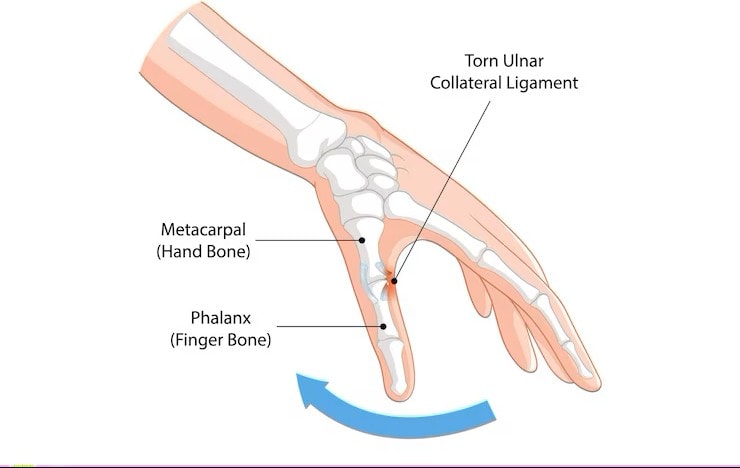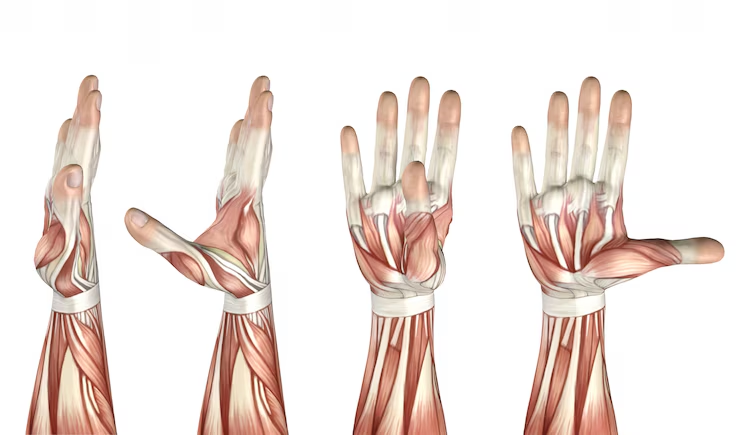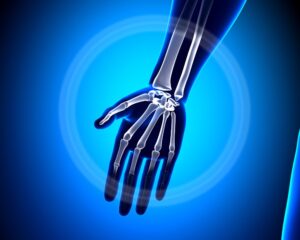The thumb is vital for hand function and everyday tasks. Its unique structure allows for gripping, pinching, and precise movements. This article covers the thumb’s anatomy, including its bones, muscles, and joints, revealing how it supports essential hand functions.
Thumb Anatomy
The thumb is an integral part of the hand, which includes the palm, fingers, and thumb itself. The thumb’s distinct structure enables a wide range of movements, making it versatile and crucial for hand function. From gripping objects to performing delicate tasks, the thumb’s role in hand movements is unparalleled.
One of the key aspects of thumb functionality is its blood supply. The blood supply to the thumb is vital for maintaining its functional utility. Damage to this supply can lead to significant impairments, affecting everything from grip strength to fine motor skills. An intricate network of arteries and veins keeps the thumb well-nourished and functional.
The thumb’s structure is a complex, three-dimensional arrangement of bones, muscles, and ligaments, all working together to allow for its extensive range of movements. This layered design provides the thumb with its distinctive shape and functionality. Next, we’ll explore the thumb’s anatomy, starting with the bones.
Thumb Anatomy Diagram

Bones of the Thumb
The thumb consists of a unique combination of bones that sets it apart from the other fingers. While other fingers have three phalanges, the thumb has only two: the proximal and distal phalanges. It also includes the first metacarpal bone, connecting it to the wrist and supporting its movements.
These bones work together to allow the thumb to perform various functions, from gripping objects to precise manipulations. The unique arrangement of the thumb’s bones is essential for its opposable nature, enabling it to touch the tips of the other fingers and perform complex tasks.
Let’s explore each of these bones in more detail.
Phalanges
The thumb’s phalanges are the two bones that form the main structure of the thumb. These include the proximal phalanx, which is closest to the hand, and the distal phalanx, located at the tip of the thumb. Unlike the other fingers, which have three phalanges, the thumb’s two phalanges provide a balance of strength and mobility.
These phalanges are crucial for thumb movement, enabling flexion and extension vital for gripping and precision tasks. Their structure provides the necessary stability.
Metacarpal
The first metacarpal bone is a key component of the thumb’s structure. This bone connects the thumb to the wrist bones through the carpometacarpal joint, providing a stable base for thumb movements. The first metacarpal bone is thicker and shorter than the metacarpal bones of the other fingers, reflecting its role in supporting the carpal bones and the thumb’s unique range of motion.
The first metacarpal bone is key for thumb function, enabling opposition to touch other fingers’ tips. Its structure and wrist connection provide remarkable versatility.
Sesamoid Bones
Sesamoid bones are small, rounded bones embedded within the tendons of the thumb. These bones enhance the mechanical advantage of the thumb’s tendons, increasing leverage for more efficient movements and greater force.
In the thumb, sesamoid bones contribute to stability and assist in movement, particularly during activities that require gripping and pinching. Their presence ensures that the thumb remains stable and capable of performing its wide range of functions.
Joints of the Thumb
The thumb’s unique mobility and dexterity are largely due to its three main joints: the carpometacarpal joint (CMC), the metacarpophalangeal joint (MCP), and the interphalangeal joint (IP). These joints work together to provide the thumb with its extensive range of motion, allowing for movements such as bending, extending, and rotating.
Each joint has a distinct structure and function, contributing to the thumb’s versatility. Here’s a closer look at each joint.
Carpometacarpal Joint (CMC)
The carpometacarpal joint (CMC) is characterized by its saddle-shaped structure, which provides the thumb with a wide range of motion. This joint allows the thumb to perform movements such as flexion, extension, abduction, adduction, and rotation.
The CMC joint’s unique structure enables the thumb to move across the palm and touch fingertips, known as opposition, crucial for grasping and manipulating objects.
Metacarpophalangeal Joint (MCP)
The metacarpophalangeal joint (MCP) operates as a hinge, allowing thumb flexion and extension between the first metacarpal bone and the proximal phalanx.
The MCP joint provides the thumb with the ability to bend at the knuckle, contributing to its overall dexterity and versatility.
Interphalangeal Joint (IP)
The proximal interphalangeal joint (IP) is the joint between the proximal and distal phalanges of the thumb. This joint allows for flexion and extension, enabling the thumb to grasp and pinch effectively.
The IP joint’s flexion and extension are essential for diverse thumb movements.
Muscles of the Thumb
The muscles of the thumb are responsible for its various movements, including:
Flexion
Extension
Abduction
Adduction
Opposition
These muscles are divided into two main groups: the thenar muscles and the extrinsic muscles.
The thenar muscles are located at the base of the thumb and are responsible for its fine motor movements. The extrinsic muscles originate in the forearm and enable powerful thumb movements. Let’s explore each of these muscle groups in more detail.
Thumb Muscle Movement Diagram

Thenar Muscles
The thenar muscles, located at the thumb’s base in the thenar eminence, include the abductor pollicis brevis, flexor pollicis brevis, and opponens pollicis. They are essential for flexion, abduction, and opposition.
The thenar muscle group forms a prominent area on the palm, providing strength and dexterity for various tasks and precise movements.
Extrinsic Muscles
The extrinsic thumb muscles, originating from the forearm, include the abductor pollicis longus, extensor pollicis brevis, extensor pollicis longus, and flexor pollicis longus. They are responsible for powerful movements requiring strength and precision.
The flexor pollicis longus is crucial for thumb flexion, while extensor muscles straighten and move the thumb away from the hand. Together with thenar muscles, they provide full range of motion.
Ligaments of the Thumb
Ligaments provide structural support and stability to the thumb, especially around the metacarpophalangeal joint, ensuring stability and preventing excessive motion.
The main ligaments of the thumb include the collateral ligaments, the volar plate, and the dorsal ligaments. Each of these ligaments contributes to the overall stability and function of the thumb.
Collateral Ligaments
The collateral ligaments include the ulnar collateral ligament (UCL) and radial collateral ligament (RCL). The UCL prevents excessive outward bending, ensuring stability and force generation for gripping.
The RCL prevents excessive inward bending. Together, these ligaments provide stability, allowing for a wide range of movements without injury risk.
Volar Plate
The volar plate acts as a barrier that limits hyperextension of the thumb, providing additional stability to the joint. This structure is essential for protecting the thumb from injuries that could result from excessive backward bending.
Besides limiting hyperextension, the volar plate cushions the thumb joint, absorbing impact and providing structural support, vital for functionality and injury prevention.
Dorsal Ligaments
Dorsal ligaments contribute to the overall stability of the thumb joint by reinforcing the joint capsule. These ligaments are located on the dorsal surface of the thumb and play a critical role in preventing excessive dorsal displacement.
Dorsal ligaments support the thumb joint and reinforce the joint capsule, ensuring stability during movements and enabling tasks that require strength and precision.
Nerves of the Thumb
Thumb nerves are crucial for controlling movements and providing sensory feedback. The primary nerves—median, radial, and ulnar—work together to ensure dexterity and responsiveness.
Each nerve plays a specific role in thumb movement and sensation, contributing to its wide range of tasks. Here’s a detailed look at their functions.
Median Nerve
The median nerve is crucial for thumb opposition, essential for grasping and pinching. It controls the thenar muscles and provides sensory feedback, enabling precise movements.
Without the median nerve, the thumb would lose fine motor control, making precision tasks difficult.
Radial Nerve
The radial nerve primarily provides sensory innervation to the back of the hand and thumb, enabling sensory awareness in the arm and forearm.
The radial nerve’s sensory feedback from the back of the hand and thumb is critical for maintaining overall functionality and responsiveness.
Ulnar Nerve
The ulnar nerve is crucial for intrinsic muscle function, facilitating precise thumb and finger movements and fine motor skills.
The ulnar nerve’s role in thumb muscle function enhances dexterity and capability for detailed and coordinated tasks.
Blood Supply to the Thumb
The thumb’s blood supply is vital for maintaining its functionality and health. The primary arteries supplying blood to the thumb are the radial artery and the princeps pollicis artery, which branch off from the brachial artery. These arteries form palmar arches that ensure the thumb receives adequate blood flow.
Adequate blood supply is essential for the thumb’s effective function, underscoring the importance of these arteries.
Radial Artery
The radial artery supplies blood to the deep palmar arch, supporting thumb perfusion. Located on the thumb side of the wrist, it ensures necessary nutrients and oxygen for effective function.
The radial artery is crucial for maintaining thumb health and capability, especially during sustained effort and precision activities.
Princeps Pollicis Artery
The princeps pollicis artery, a radial artery branch, supplies blood directly to the thumb, ensuring adequate blood flow for its functions.
The princeps pollicis artery is vital for maintaining thumb health and functionality.
Venous Drainage
The venous drainage of the thumb is managed by the dorsal venous network, which collects blood from the thumb and drains it into larger veins. This network ensures that deoxygenated blood is efficiently removed from the thumb, maintaining its overall health.
Proper venous drainage by the dorsal venous network prevents swelling and venous congestion, crucial for thumb function.
Functional Anatomy of the Thumb
The functional anatomy of the thumb supports various movements, including flexion, extension, and opposition, allowing it to perform tasks requiring strength and precision.
Various ligaments, muscles, and joints collaborate to give the thumb its remarkable versatility. Here are some key functional aspects.
Opposition
Opposition allows the thumb to touch the fingertips, enhancing grip. This movement is crucial for precise tasks like writing, typing, and manipulating small objects, showcasing the importance of a fully opposable thumb.
Opposition is a defining feature of the human thumb, enabling a wide range of functions and enhancing overall utility.
Grip and Pinch Strength
Thumb grip strength is essential for holding and manipulating objects, enabling both power grips for larger items and a precision grip for smaller ones.
Generating strong grip and pinch forces is crucial for daily activities, from opening jars to using tools, underscoring the importance of thumb strength.
Fine Motor Skills
Thumb fine motor skills contribute to precision activities like writing and buttoning clothing, essential for intricate tasks requiring high dexterity.
The thumb’s unique structure and muscle arrangement make it indispensable for performing these tasks with ease.
Clinical Considerations
Injuries to the thumb often result from forceful impacts or awkward positioning during sports activities, ranging from mild sprains to severe fractures, affecting function.
Common thumb issues include ligament injuries, fractures, and arthritis. Here’s a detailed look at these injuries and their impacts.
Common Injuries
Common thumb injuries include:
Skier’s thumb: Occurs when the ulnar collateral ligament is injured due to extreme abduction or hyperextension.
Bennett’s fracture: Involves a fracture at the base of the thumb metacarpal, complicating thumb movement.
Trigger thumb: Involves tendon issues causing the thumb to stick in a bent position.
These injuries can significantly impact thumb function and may require medical intervention for proper healing.
Arthritis
Thumb osteoarthritis often causes pain, swelling, and decreased range of motion, severely limiting movement and affecting hand function.
Rheumatoid arthritis can cause significant pain and deformity in the thumb joints, further impairing everyday tasks. Both types of arthritis require proper management to maintain functionality and reduce pain.
Surgical Interventions
Severe thumb injuries or unresponsive conditions may require surgical interventions. Thumb reconstruction may be needed for severe injuries, and joint replacement is considered when arthritis limits movement and causes persistent pain.
Surgical repair of thumb ligament injuries often involves reattaching the ligament using pins or anchors for proper healing, aiming to restore function and improve quality of life.
Thumb Muscles
The thenar muscles consist of three key muscles: abductor pollicis brevis, flexor pollicis brevis, and opponens pollicis, which are crucial for thumb movement. These muscles facilitate the abduction, flexion, and opposition of the thumb, enabling it to perform a wide range of tasks.
The abductor pollicis brevis originates from the scaphoid and trapezium bones and is essential for the thumb’s abduction at the carpometacarpal joint. The opponens pollicis muscle is responsible for the thumb’s opposition, a critical movement that combines flexion, adduction, and medial rotation.
Thumb Tendons
The thumb’s tendons connect muscles to bones, facilitating essential movements needed for grip and dexterity. The Abductor Pollicis Longus (APL) tendon moves the thumb away from the hand and is positioned on the radial side of the wrist.
The Flexor Pollicis Longus (FPL) tendon, unique to humans, enables the flexion of the thumb by connecting the forearm muscle to the distal bone of the thumb. The Extensor Pollicis Longus (EPL) tendon straightens the distal joint of the thumb, functioning through a pulley mechanism at Lister’s tubercle.
Thumb Mobility and Grip
Approximately 40% of hand function is attributed to the thumb, highlighting its essential role in hand movements. The thumb provides crucial support for both power grips, which involve holding larger objects, and precision grips for manipulating smaller items.
Due to its functionality, the thumb is vital for daily activities such as writing, eating, and using tools. The thumb’s opposable nature is crucial in forming a power grip, enabling a strong grasp on larger objects like tools or sports equipment.
Common Thumb Injuries
Common thumb injuries include:
Skier’s thumb: UCL injury due to excessive force while holding an object.
Bennett’s fracture: Unstable fracture at the base of the first metacarpal.
Rolando’s fracture: Complex three-part fracture at the base of the thumb metacarpal.
Trigger thumb: Tendon issues causing the thumb to stick in a bent position.
These injuries can significantly impact thumb function and may require medical intervention for proper healing.
Thumb in Evolution
The distinct human thumb evolved to facilitate a more effective grip for throwing and using tools, which were crucial behaviors that emerged with the adoption of bipedalism. Studies suggest that the evolution of the human thumb was driven by the need for effective tool use, which required both strength and precision in grip.
Improved abilities for throwing objects and using weapons enhanced reproductive success. The evolution of the thumb optimized human dexterity, playing a significant role in survival. Anatomical changes in the human hand, such as a more robust thumb, can be traced back to the early hominids’ need for effective tool use.
The evolution of the thumb has had a profound impact on human capabilities, enabling us to perform complex tasks that require both strength and precision.

